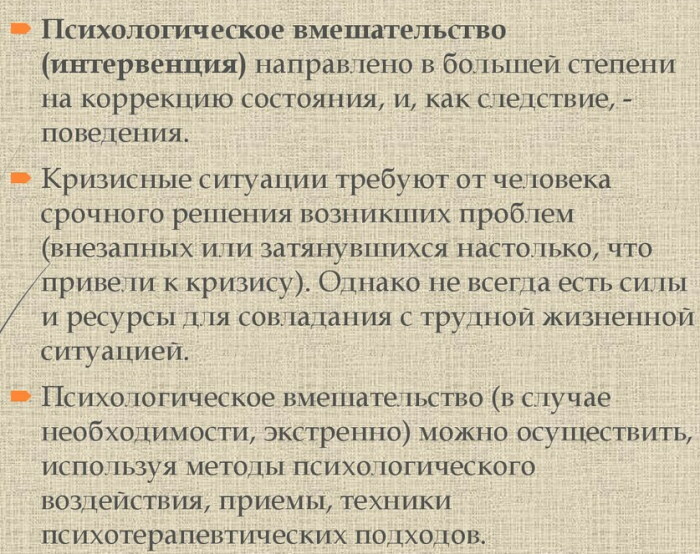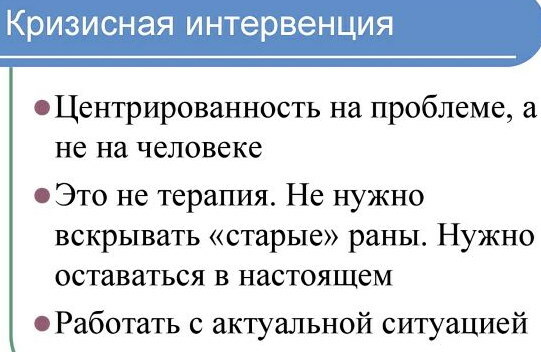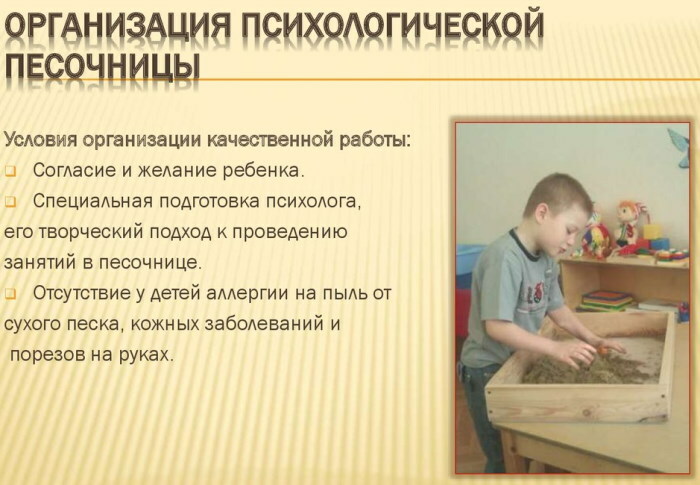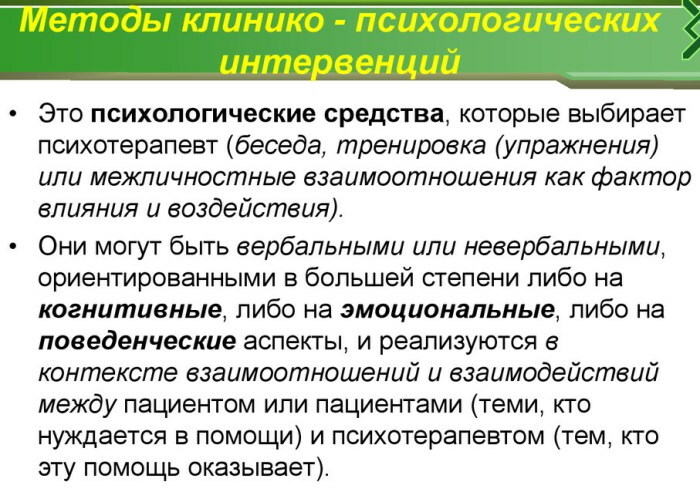Content
- Definition
- Description of the concept
- Views
- Supportive
- Retraining
- Personality orientation
- Depending on the shape
- By time
- By directive
- Methods of exposure
- Sandbox method
- Empty chair
- Primary therapy
- The illusion of hunger
- Psychological Intervention Video
Intervention in psychology is usually understood as psychotherapeutic effect with specific goals achieved by means of special means and methods of influence.
Introduced into psychology by M. Perret and W. Baumann's term is widely used in clinical psychology and pedagogy and implies therapeutic techniques designed to improve the general condition of the individual, to help him cope with the emerging psychological problems or depression.
Definition
Intervention in psychology is, in accordance with the characteristics given by the famous Russian psychiatrist V.A. Zhmurov, any procedure (technique) making it possible to intervene in a particular process in the body (surgery, psychotherapeutic counseling).
Clinical psychology defines the concept of "intervention" as derived from the Latin term interventio (violent intervention) any impact used to interrupt or change the current process.
Specialists of clinical psychology distinguish E. Lindermann, crisis intervention, understood as emergency medical and psychological assistance to persons in crisis. At the same time, a crisis is defined as a negative state that has arisen in a person, which manifests itself when the activity that is significant for him is blocked.
According to E. Erickson, a protracted, chronic crisis can lead to social maladjustment of a person, suicide, neuropsychic or psychosomatic suffering. The manifestation of crisis intervention acts as a form of hotline services, family psychologists and offices that provide social and psychological assistance.
The main purpose of their work is to help:
- children and adolescents who have left their families or faced abuse by their parents;
- drug addicts and persons suffering from alcohol intoxication;
- war veterans and disabled people;
- single parents and women in difficult life situations or faced with violence.
The need for crisis intervention increases significantly during disasters, emergencies, natural disasters and social upheavals.
Description of the concept
In practical and social psychology, it is customary to understand "intervention" as any psychological intervention in a person's personal space to stimulate positive changes in it. A prerequisite for this is the desire for change, expressed by the individual himself, as well as his willingness to cooperate.
According to M. Perret and W. Baumann in psychology, the psychological type of interventions is used, which differ depending on the scope of application on:
| Types of intervention | Methods of its influence |
| Pedagogical and psychological | It is widely used when working with children and adolescents and consists of.
|
| Labor and organizational-psychological | A wide range of psychological interventions include:
|
| Clinical and psychological | It represents the essence of psychotherapy and includes the choice:
|

In accordance with the theory of M. Perret and W. Bauman, psychological interventions are characterized by:
- Methods of clinical and psychological influence (verbal or non-verbal), chosen by the psychotherapist to change the mental processes and state of the individual.
- Functions aimed at treating and preventing psychiatric dysfunctions of a person.
- The goals that contribute to the achievement of certain changes and determine the overall strategy of influence.
- Theoretical substantiation - scientific psychology, psychological theories and concepts.
- Empirical verification - scientific research proving effective certain methods of influence.
- Professional actions carried out by specialists who have undergone specialized training.
One of the methods of intervention is psychological correction, which affects certain psychological structures and ensures the full development and functioning of the individual.
Views
Intervention in psychology is actions aimed at changing the psychological state of a person (Doctor of Medicine L.R. Volberg).
The classification of the methods of psychotherapeutic intervention developed by him is built depending on the goals set for them and distinguishes 3 types of intervention:
Supportive
Aimed at treating people with chronic and disabling mental illness, the technique has a stimulating effect on their surviving the ability to possibly maintain the resistance of healthy elements of the psyche to deficits and losses caused by mental illness or old age.
The most important supportive psychotherapy for depressive mood disorders associated with the onset of dementia and manifested with the limitation of certain psychological functions.
Supportive psychotherapeutic intervention includes periodic meetings with a psychotherapist, held in the form of a conversation and aimed at helping a person to resolve specific problems.
Retraining
It is carried out using various psychotherapeutic techniques aimed at changing patient behavior with the support and approval of positive behaviors and disapproval negative.
The technique is widely used to correct the deviant behavior of minors and persons with a criminal past and includes:
- periodic conversations with a psychotherapist;
- trainings aimed at studying the patient's behavior, its characteristics;
- psychological games designed to develop new ways of behavior for the individual in specific situations.
Personality orientation
The technique includes psychotherapeutic interventions carried out with the aim of understanding intrapsychic conflicts that are the source of personal disorders, and the desire to achieve significant changes in character traits and restoration of the full value of individual and social functioning personality.
The methods of therapeutic and orientational influence are used in neurology and borderline psychotherapy. Their help is necessary in solving the difficulties and problems that arise in a healthy or relatively healthy person, and is aimed at the emergence of personality changes.
Personality-oriented intervention is used:
- with neuroses;
- with borderline personality disorders;
- with adjustment disorders;
- if necessary, personal growth.
Depending on the shape
Depending on the form of the psychotherapeutic intervention, which consists in the organization and structure of the interaction between the therapist and the patient, the following are different:
- Group intervention. The form of psychotherapeutic intervention by I. Yaloma in which a specially created group of people meets regularly under the guidance of a psychotherapist to achieve the following goals:
- resolution of internal conflicts;
- relieving stress;
- correction of deviations in behavior and other psychotherapeutic work.

- Family psychotherapeutic intervention is, in accordance with the concept of A.A. Bogdaleva, negotiations between family members in the presence a psychotherapist, aimed at optimizing family functioning, openly discussing their feelings and desires, family members' awareness of their unity and functions performed.
- Individual psychotherapeutic intervention, represented by a specially organized form of interaction between the psychotherapist and the client (patient), based on helping and supporting the client from the psychotherapist in order to resolve problems or overcome life difficulties.
By time
Depending on the time of the psychotherapeutic methods, there are:
- Long-term intervention, consisting in the work of the client with a specialist for more than six months (20 meetings) and contributing to the appearance of significant internal changes. The technique is aimed at changing patients' entire sense of themselves.
- Short term intervention. A type of psychological counseling that focuses on the client's current symptoms and current life circumstances, limited in time to a few sessions and helps to accentuate, emphasize and identify strengths client side.
By directive
Depending on the form of psychotherapeutic intervention and the choice of a specific role by the psychotherapist, the following differ:
- Directive psychotherapy. It is based on the authoritative role of a specialist who chooses the methods and methods of conducting psychological intervention, and requires a clear division of the roles of "doctor-patient". All techniques of hypnosis and near-hypnotic influence are referred to the methods of directive intervention.
- Non-directive technique. Introduced by K. Rogers, a form of treatment in which the doctor does not attempt to diagnose the patient, to interpret it state, and makes efforts to create during the sessions a warm, friendly, understanding and accepting atmosphere.
Methods of exposure
Intervention in psychology is a way to change human feelings, behavioral norms or improve the general condition of a person (practicing psychologist, gestalt therapist Pogodin I.A.).
The main essence of the intervention, according to the specialist, is its ability to significantly influence the behavior of the patient with the help of specific psychological techniques. Lead to positive changes in the thoughts, state of mind and behavior of a person, help him improve relationships with people around him.
The most popular interventions are:
Sandbox method
The method of intervention, developed by the Swiss Jungian analyst Dora Kalf, helps a person to find inner world, and also contains the potential necessary for the development of intellectual and spiritual aspects personality. The task of the therapist here is aimed at helping the client (most often the child) learn to show their inner strength.
The sandbox method itself takes its origins from the book "Games on the Floor" by G. Wells and is based on the client's creation of a three-dimensional painting on a tray of sand using miniature figures representing his life aspects and fantasies. The figures for the composition are located near the container, and in addition to this, the client has a large number of a variety of building materials, allowing you to independently make any necessary for him shape.
During work, the therapist does not give the client any instructions, focusing only on his imagination, thanks to which the time of modeling and moving figures along the tray, the psyche of the individual is gradually transformed into healthier, new forms.
Empty chair
Developed by Dr. M. Moreno and modified by Dr. M. Perls technique aims to provide a permanent move from discussing the situation assistance to a person in his thoughts to real actions, which allows him to gain new experience and try to change the prevailing situation.
During the session, the doctor puts an empty chair in front of the client, inviting him to imagine absolutely any person sitting on it, and then start talking to him using words or gestures.
Experts note that at the beginning of the session, the patient may be skeptical about the procedure, but after the start conversation with an imaginary interlocutor is gradually pronounced, discussing difficult questions and getting on them necessary answers.
Primary therapy
Widespread thanks to the works of K. Jung's therapeutic technique, used to treat neuroses of various spectrum, as well as depression and anxiety, and has as its goal the process of gradual healing of a person, with the help of the correct living of the traumatized him situations.
The task of the technique is to return the client to his original, neurophysiological state, release from suppressed feelings that are a consequence of trauma and suppressed emotions.
The illusion of hunger
The method of psychological influence, developed by D. Weinberg, is effectively used to treat alcohol and drug addiction, overeating and other psychological problems associated with the manifestation of unconsciousness.
The essence of Weinberg's technique is that a person is characterized by stereotyped behavior that occurs at the moment the impulse of habit appears. The so-called "illusory feeling of hunger" by the psychologist.
In the process of therapeutic work, the individual learns to stop his unconscious impulses by:
- determining the moment when he is inclined to act automatically;
- exclusion of actions taking place on the machine;
- the study of thoughts and feelings, while arising.
The essence of the technique, according to D. Weiner is based on the fact that at the moment when a person consciously tries to turn on an automatic reaction, he experiences a feeling comparable to hunger and at this very moment returns to the moment of formation habits.
For example, if a person is used to getting up during a telephone conversation, at the moment of consciously turning on the automatic reaction, mentally returns to childhood when he was forced to get up so that classmates could see and hear what he was trying to tell them.
Becoming an adult, an individual unconsciously uses the behavior he needs in childhood, and after analyzing the situation and the reasons for its occurrence, he can understand that he no longer needs the old habit.
This intervention can be used in the analysis of a variety of situations, giving an individual the opportunity to understand why he has a desire:
- eat chocolate;
- drink an alcoholic drink;
- use obscene language in a conversation;
- make a joke in a difficult situation.
By stopping himself in front of an automatic action, a person, according to psychologists, gives himself the opportunity to understand what exactly is happening in his thoughts and try to get rid of it.
Psychological intervention is a process designed to change the psychological, mental and emotional state of a person in a positive way. The methods of intervention used in psychology are creative, based on authority specialist or are conducted in a friendly environment and have as their goal to improve the quality of life the individual.
Psychological Intervention Video
How to build a cool therapeutic intervention:



